As an Amazon Associate, we earn from qualifying purchases with no additional costs for you.
Keeping your knives sharper for longer is not only convenient but can also help to extend the life of your knives. Ensuring your knives are sharp also means you have a sharp knife available when you need it. What are the best methods to preserve the edge on your knives and keep them sharper for longer?
Preserving your knife’s cutting edge keeps it sharp for longer, reducing the frequency of sharpening. Follow these five tips to keep your knife sharp.
- Hone Your Knife
- Store Your Knives Correctly
- Clean Your Knives Correctly
- Don’t Cut On A Hard Surface
- Don’t Drag Your Knife Across The Cutting Board
There is nothing more frustrating than reaching for a knife only to find that the edge is not as sharp as it should be, making your cutting task more difficult! The only way to avoid this problem is to take some simple steps to protect your knives’ cutting edge. We have compiled some useful tips and strategies to do just that!
If you are interested in checking out the best whetstones for your knives, we recommend and use you can find them by clicking here (Amazon link).

Why Won’t My Knives Stay Sharp?
Owning knives comes with a responsibility to maintain your knives to ensure that they stay sharp and are ready for use at all times.
However, there are certain strategies you can use to keep your knives sharper for longer periods between sharpening sessions. Before we investigate what you can do in this regard, take a look at what causes your knives to lose sharpness.
Understanding the situations that affect a knife’s sharpness will give insight into keeping the knife’s edge at optimal sharpness.
Why Do Knives Lose Sharpness?
There are many reasons for a knife losing sharpness; some are preventable, while others are due to normal use of the knife.
Being aware of these causes for a knife losing sharpness can help you to be more cognizant of these issues when using or maintaining your knives.
Reasons knives lose sharpness include the following.
- Quality of the steel. A knife made from poor-quality steel or soft steel will not hold a sharp edge for very long and will lose sharpness every time you use it.
- Impact on a hard surface. Using the knife on a hard surface will dull the knife.
- Inappropriate use of the knife. Using a knife to cut something it was not intended to cut will cause the blade to dull faster than expected or damage the cutting edge.
- Incorrect storage of the knife. Storing the knife in a manner that does not protect the edge is a major cause of a knife losing sharpness.
- Improper washing of the knife. The way a knife is washed can reduce the sharpness of the knife.
- Incorrect sharpening of the knife. If the knife is not sharpened to the correct angle on the secondary bevel, it can affect the edge-holding capability of the knife.
The cause of a knife losing sharpness is when the fine, thin metal on the cutting edge rolls over to one side or the other or when the edge becomes wavy or out of alignment with the knife’s spine.
Why Does My Knife Get Dull So Fast?
If you are having an issue with knives losing their sharpness fast, you may be interested in some of the main reasons this is happening.
The most common reason for knives losing sharpness fast is due to poor-quality steel used in the manufacture of the knife. The only way to avoid this issue is to purchase quality knives rather than cheap grocery store knife sets.
The second most common reason for knives becoming dull fast is when knives are used for purposes for which they are not intended. This problem is especially prevalent with kitchen knives, where it is easier to reach for the closest knife on hand rather than retrieve the right knife for the task.
The final most common cause for knives becoming dull fast is incorrect storage and cleaning of the knives. Give your knives the correct treatment when cleaning or storing them to overcome this issue. We have some tips regarding storage and cleaning that will help you avoid this problem with your knives.
For those knife owners who sharpen their own knives, there is also the possibility that you are not maintaining the correct angle when sharpening the knife. Inexperience with sharpening can result in incorrect sharpening angles.
A knife sharpened at an incorrect angle for the design of the blade will result in a knife that does not hold its edge very long and will become dull quickly when used.
TIP: We all know that knives are meant to be sharp and that a dull knife is said to be more dangerous to use than a sharp one. But can a knife be too dull to sharpen? Find out the answer in the article below:
Can A Knife Be Too Dull To Sharpen? Here’s the Answer
How Do You Keep Your Knife Sharp Between Sharpenings (Longer)?
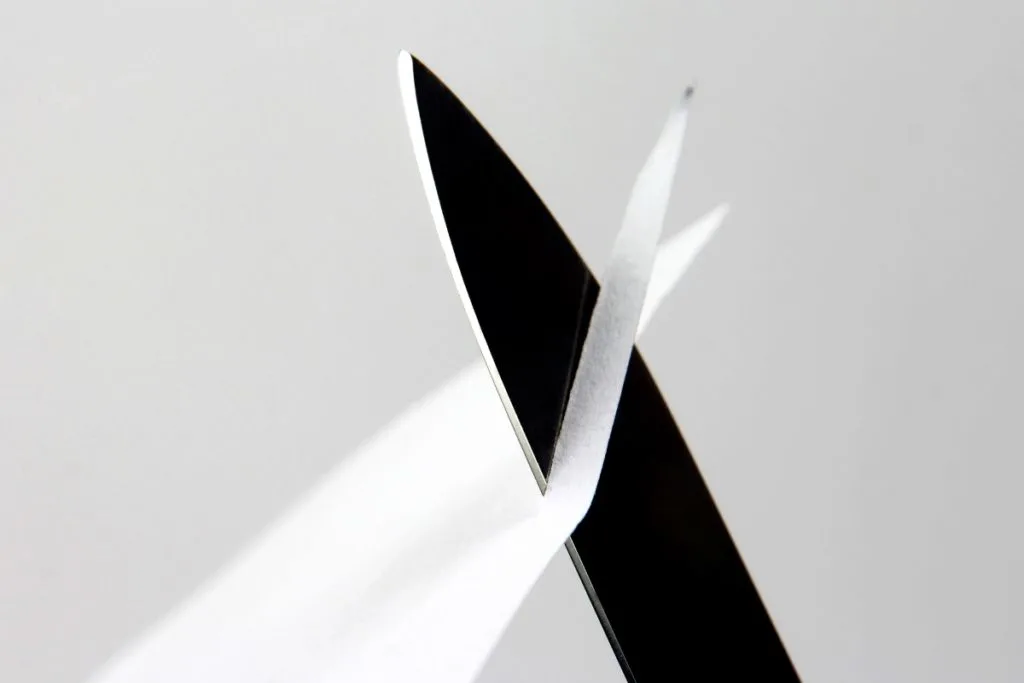
One of the key aspects to increase the longevity of your knife is to reduce the frequency with which you sharpen your knives. Knife sharpening removes metal from the knives’ cutting edge, which reduces the knives’ useable life.
It is not feasible or safe to work with a dull knife, so how can you keep your knives sharp between sharpenings to extend the time interval between sharpenings?
We have some tips on keeping your knife sharper for longer, which will help you reduce the frequency of sharpening without running the risk of working with a dull knife.
TIP 1 – Hone Your Knife
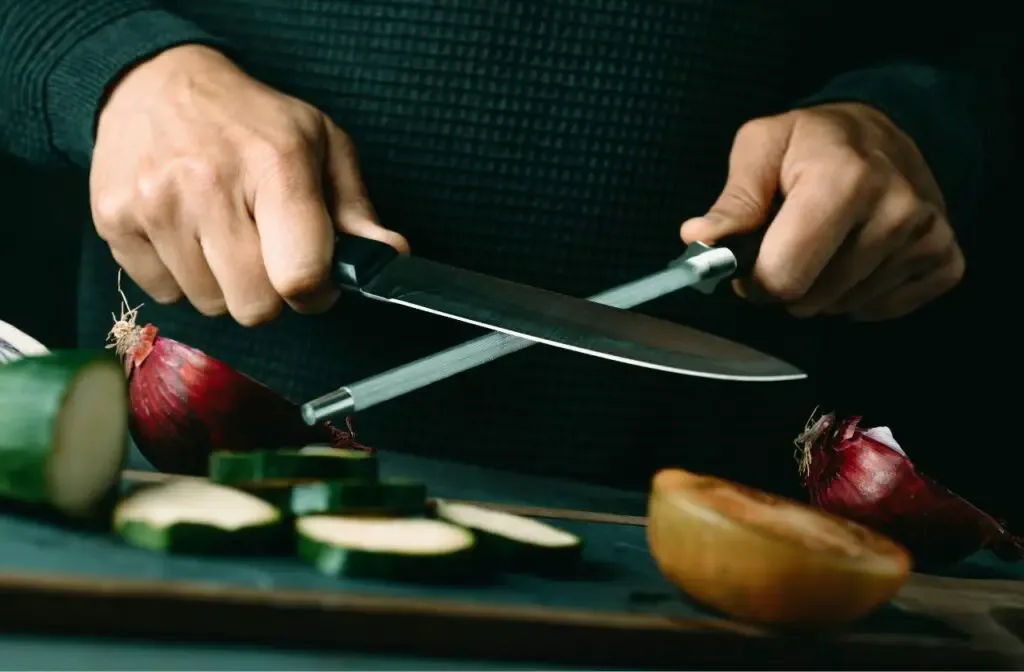
A knife can lose some of its sharpness, making the edge not keen enough to work efficiently but not dull enough to require sharpening. Honing a knife’s edge is a way to keep the knife sharp without taking it to a coarse whetstone and removing too much material unnecessarily from the edge.
The edge experiences wear with the normal use of a knife and can roll over slightly or become misaligned from the blade’s axis. This can cause the knife to feel like it has lost some of its sharpness and that it requires sharpening.
In most cases, the knife does not require sharpening but rather honing, which re-aligns the cutting edge and restores sharpness to the blade. Honing does not remove metal from the edge of the knife, making it less destructive on the blade than sharpening.
Frequent honing will keep the knife sharp for longer and increase the time between major sharpening sessions required on the blade.
The way to hone your knife will depend on the type of knife you have and the tools you have available for honing.
The tools you can use to hone a knife are as follows.
- A honing rod. A honing rod, sometimes called honing steel, can be used to re-align a knife’s edge. Honing rods can be made from ceramic, diamond, or steel material. The only knives you should never hone with a honing rod are Japanese kitchen knives.
- A high grit whetstone. A whetstone with a grit level of over 1000 grit can be used as a honing stone. The sharp edge can be restored with 2 or 3 passes of the blade over the stone. One of the best grits to use for honing is a 3000-grit whetstone. This honing method can be used on all knives, including Japanese kitchen knives.
- A leather strop. A leather strop is simple to use, and you can make your own strop with a few basic DIY skills. The leather strop must have a firm backing, such as a woodblock. All knives can be honed on a strop, including Japanese kitchen knives.
Honing your knife can be done once a week or as often as the edge needs to be touched up to restore sharpness.
TIP: People new to knife sharpening may not be aware of the terminology around knife sharpening and the nuances between the different processes. Check out the main differences between sharpening and honing in the article below:
Sharpening vs. Honing: Simple Explanation & Differences
TIP 2 – Store Your Knives Correctly
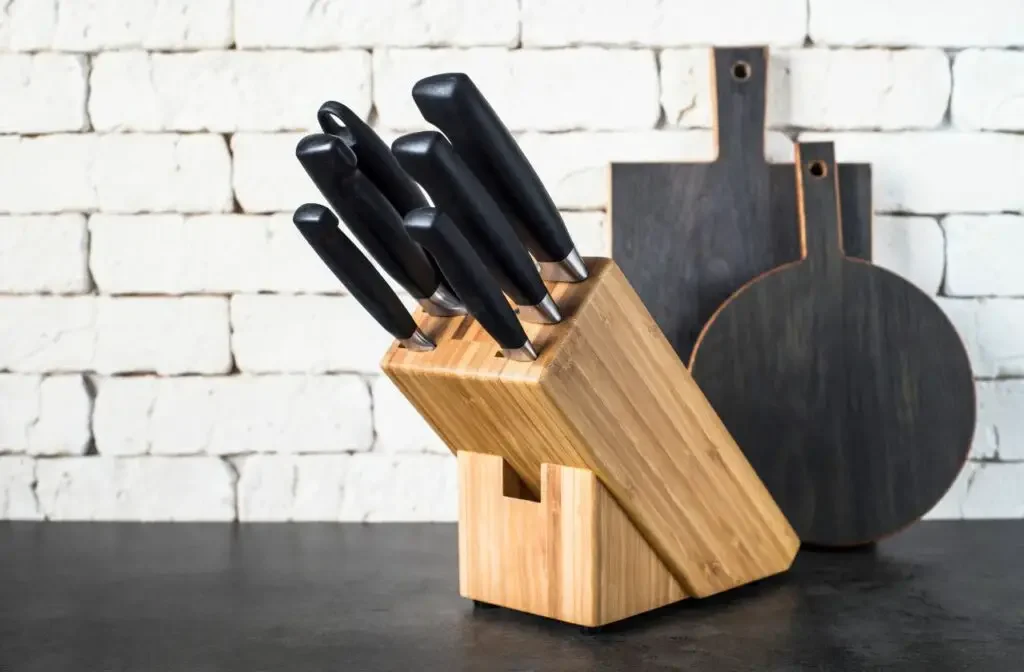
Correctly storing your knives is a key discipline that will help to keep your knives sharp. Many people make the mistake of keeping their knives in a kitchen drawer with other kitchen utensils with the blade unprotected.
The knives will get jostled about in the drawer, causing the cutting edge to become dull from impact with other knives and utensils and even the draw itself.
Your knives should be kept on a good quality magnetic wall-mounted strip, a quality knife block, or with individual blade covers.
The only way to store knives safely in a kitchen drawer with other utensils is to have individual blade covers or sheaths for your knives. Many Japanese kitchen knives come with their own custom wooden sheath for this purpose.
BTW: If you want to know more about Japanese and other knives and their sharpening, check out the books listed above. These books are recommended by professional sharpeners and knife makers (Amazon links):
- Japanese Kitchen Knives: Essential Techniques and Recipes
- The Knifenerd Guide to Japanese Knives
- Knife: The Culture, Craft, and Cult of the Cook’s Knife
- Sharp: The Definitive Introduction to Knives, Sharpening, and Cutting Techniques, with Recipes from Great Chefs
TIP 3 – Clean Your Knives Correctly
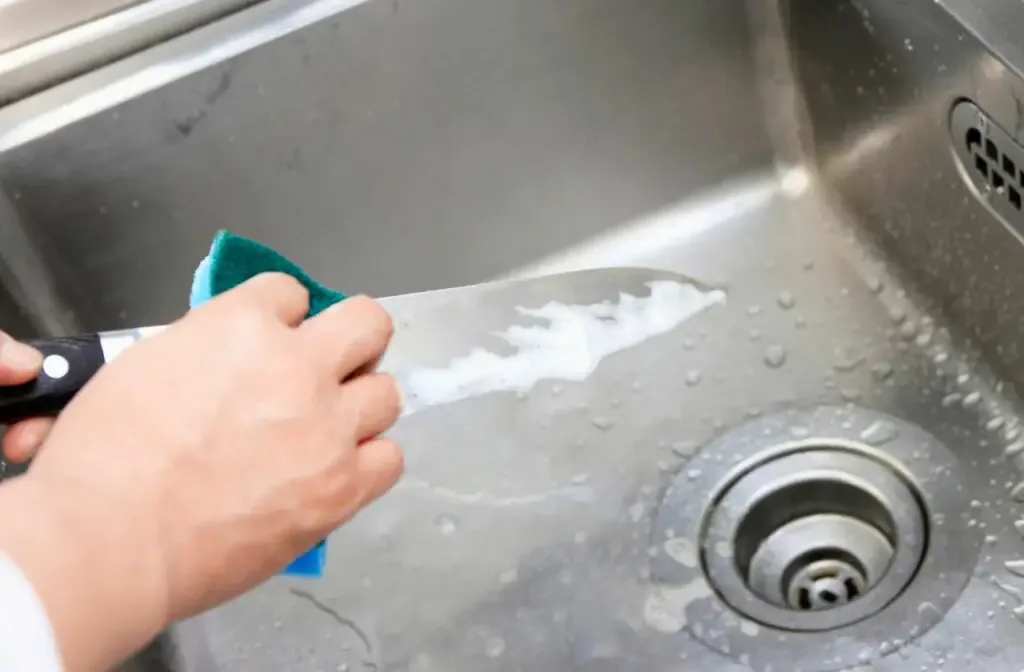
Many people are not aware that incorrectly cleaning a knife can cause the knife to become dull and even damage the thin cutting edge.
The worst method to clean your knives is to pop them in the dishwasher. The high pressure of the water in this machine will cause the knife to bounce around in the rack and possibly collide with other items in the machine.
This excessive impact during the machine’s cycle can negatively affect the knife’s cutting edge, resulting in the knife losing sharpness or sustaining severe damage to the cutting edge.
The best method to clean your knife is under warm running water and using a soft cloth with some mild dishwashing soap. Once the knife has been washed and rinsed, thoroughly dry the knife before storing it.
TIP: Do you know why dishwashers ruin your knives? And what knives are safe? Check out the complete explanation in the article below:
Guide: Why Dishwashers Ruin Knives & What Knives Are Safe
TIP 4 – Don’t Cut On A Hard Surface
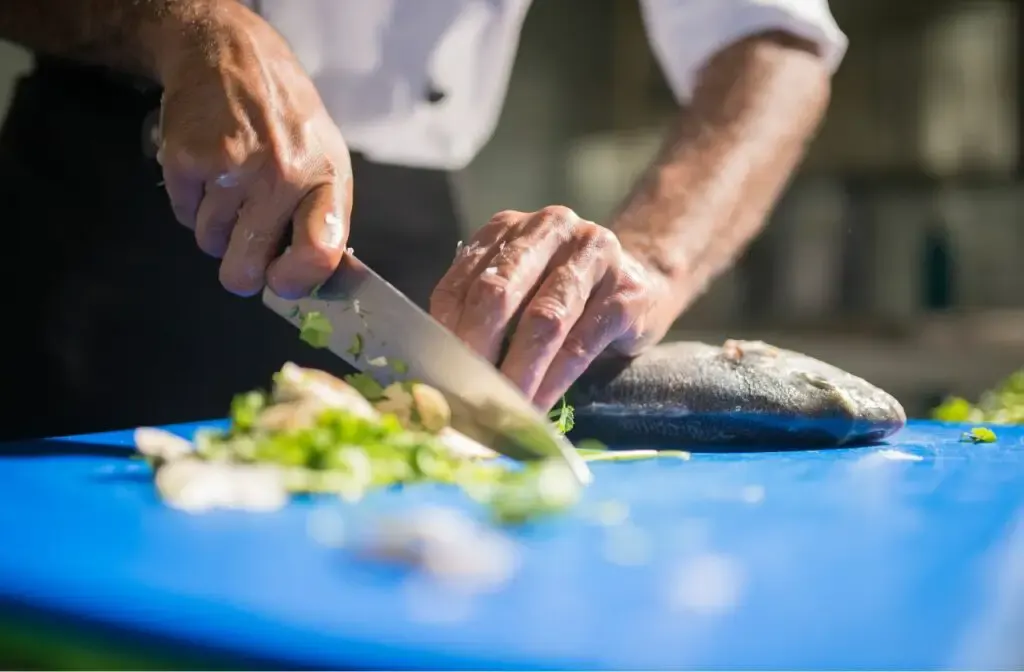
Hard-cutting surfaces are not friendly to the sharp edge of a knife. Cutting on a hard surface can roll the knife’s sharp edge, push the edge out of alignment, chip, or even crack the fine metal edge of the knife.
Surfaces that should not be used to cut on are ceramic plates, granite countertops, glass cutting boards, granite cutting boards, or metal prep tables.
These surfaces can quickly dull the knife’s cutting edge, requiring a sharpening session to restore the edge.
To avoid an increased frequency in sharpening your knives, you should avoid using these hard-cutting surfaces for your food preparation.
Wood, bamboo, and food-safe plastic cutting boards are better for the health of your knife’s cutting edge and reduce the amount of sharpening your knives will require.
TIP 5 – Don’t Drag Your Knife Across The Cutting Board
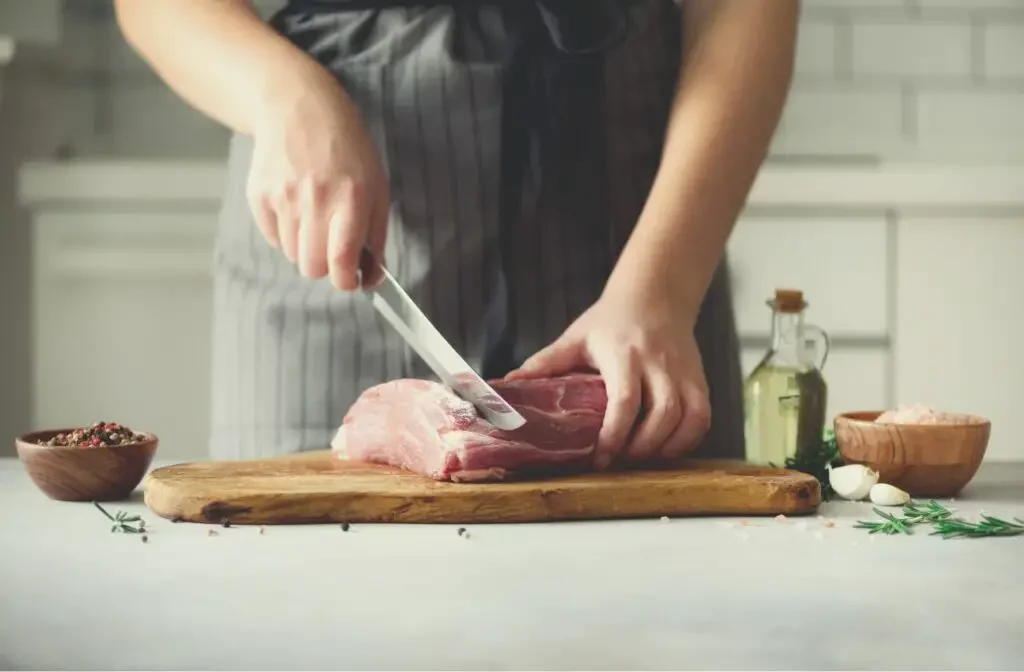
Many people are in the habit of sliding the sliced ingredient out of the way by pushing the chopped or sliced sections with a lateral dragging movement of the knife across the cutting board.
While this may be an efficient movement to clear your work area, particularly if you have some more slicing or chopping to do, it can be detrimental to your knife’s cutting edge.
Most cutting boards have ridges and grooves and various imperfections on their surface from use over time. Dragging the sharp edge sideways across the imperfections on the cutting board can roll the edge or push it out of alignment.
This technique is particularly unhealthy for high-carbon steel Japanese kitchen knives since it can cause gouges and chips in the sharp edge.
If you use this technique, you need to lift the knife slightly to ensure it does not contact the cutting board when you push the ingredients out of the way.
TIP: When people start sharpening their own knives, they find that some knives are hard to sharpen. Check out the explanation of why some knives are hard to sharpen in the article below:
5 Reasons Why Some Knives Are Hard To Sharpen & What To Do
How Do Professional Chefs Keep Their Knives Sharp?
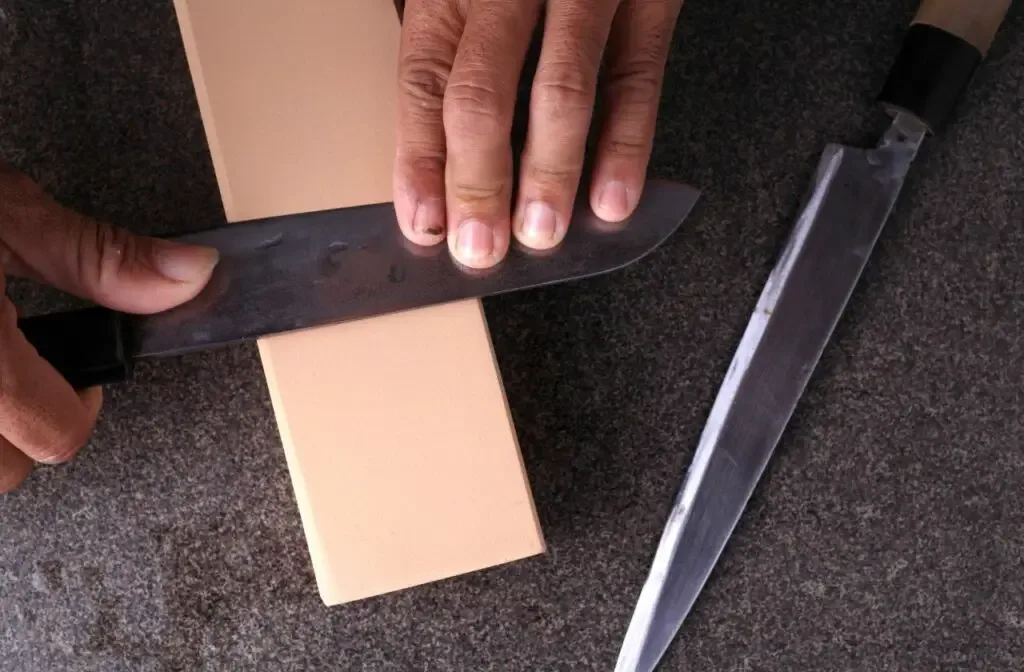
Professional chefs know the value of keeping their knives sharp and on the cutting edge in optimal conditions. Many professional chefs use expensive knives, which is an additional motivation to keep their knives in good condition.
Most professional chefs will keep their knives sharp by regularly honing the edge. Honing is usually done immediately before using the knife in the kitchen and after using the knife. After use, the knife is usually washed, dried, and honed before storage. The knives will be sharpened every 4 to 6 weeks.
Many professional chefs do not sharpen their own knives but prefer to outsource this task to experienced knife-sharpening professional services. This way, they can be sure their knives are sharpened to the correct angle and the edge will be durable.
TIP: Are you looking to buy a new whetstone? Check out our recommendations (we personally use the first three ones):
Our PRO choice whetstones combo (Amazon links):
- Fixing stone: Whetstone SHAPTON Ceramic KUROMAKU #320
- Sharpening stone: Suehiro CERAX soaking whetstone: Medium #1000
- Finishing stone: Whetstone SHAPTON Ceramic KUROMAKU #5000
Our budget choice (Amazon link): Sharp Pebble Extra Large Sharpening Stone Set
FAQs: Knife Sharpening and Maintenance
Q: How often should I sharpen my knives?
A: The frequency of sharpening depends on the usage and type of knife. For regular home cooks, sharpening every 2-3 months is sufficient. However, professional chefs or those who use their knives heavily might need to sharpen them every few weeks.
Q: Can I use any sharpening stone for my knife?
A: Not all sharpening stones are suitable for every knife. It’s essential to choose a stone that matches the hardness and material of your knife. For instance, Japanese knives, which are typically harder, may require specific whetstones.
Q: Why is my knife getting dull quickly?
A: Several factors can cause a knife to dull quickly, including the quality of the steel, cutting on hard surfaces, improper storage, and using the knife for tasks it’s not designed for.
Q: Is it true that a dull knife is more dangerous than a sharp one?
A: Yes, a dull knife requires more force to cut, increasing the risk of the knife slipping and causing an injury.
Q: How do I know if my knife needs honing or sharpening?
A: Honing realigns the edge of the knife and should be done regularly, even after every use. Sharpening a knife removes material from the blade to create a new edge and is needed less frequently. If honing doesn’t restore the knife’s performance, it’s time to sharpen.
Q: Can I sharpen serrated knives?
A: Yes, but serrated knives require a different technique and tool, usually a tapered sharpening rod, to sharpen each serration individually.
Q: How should I store my knives to maintain their sharpness?
A: Store knives in a knife block, on a magnetic strip, or in individual blade guards. Avoid storing knives loose in a drawer where they can jostle against other items.
Q: Is it okay to wash my knives in the dishwasher?
A: It’s recommended to hand wash knives. Dishwashers can cause knives to bang against other items, potentially damaging the edge and reducing sharpness.
Q: What’s the difference between honing and sharpening?
A: Honing realigns the edge of the knife without removing material while sharpening grinds away material to create a new edge.
Q: Are there any foods or materials I should avoid cutting to maintain my knife’s edge?
A: Avoid cutting on hard surfaces like glass, granite, or metal. Also, refrain from using your knife to cut frozen foods, bones, or other hard materials.
Conclusion
Keeping your knives sharp does not mean taking out the whetstones and going through all your whetstone grits. Taking some basic measures to preserve the edge of the knife will ensure that it stays sharper for longer and reduce the frequency of sharpening.
Keeping the knife sharp will reduce wear on the knife, giving you a longer-lasting knife and a knife that is always sharp and ready to be used!
TIP: The best way to keep your knives sharpened is using whetstones. Check out the complete guide on how to properly sharpen knives on whetstone in the article below:
Step-By-Step GUIDE: How To Sharpen A Knife With A Whetstone
